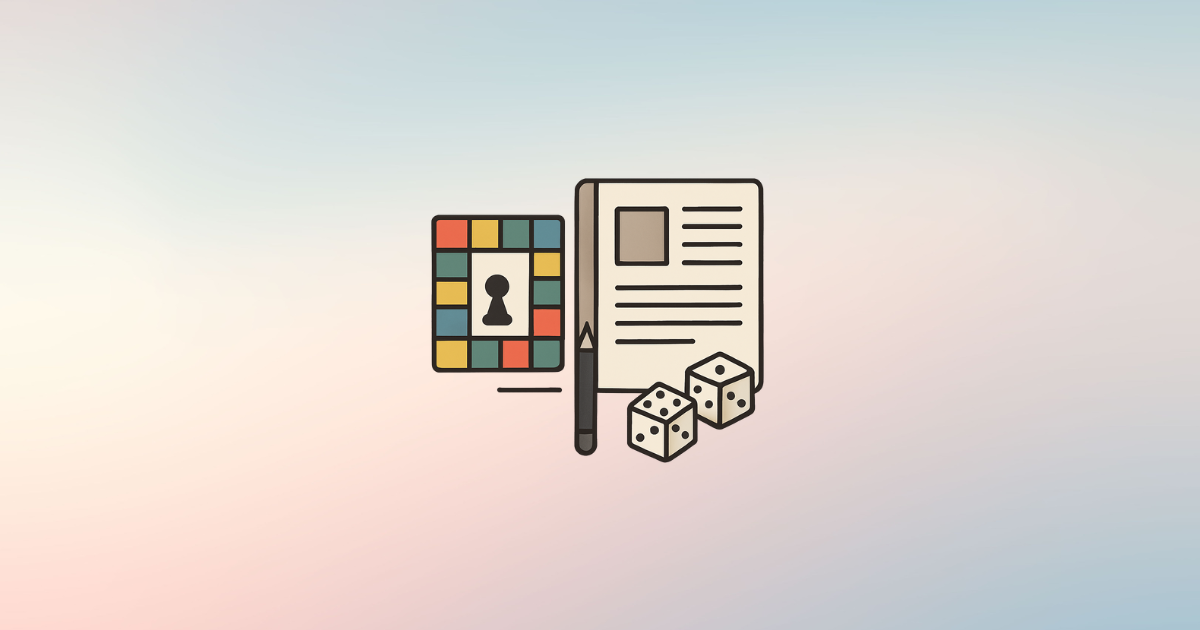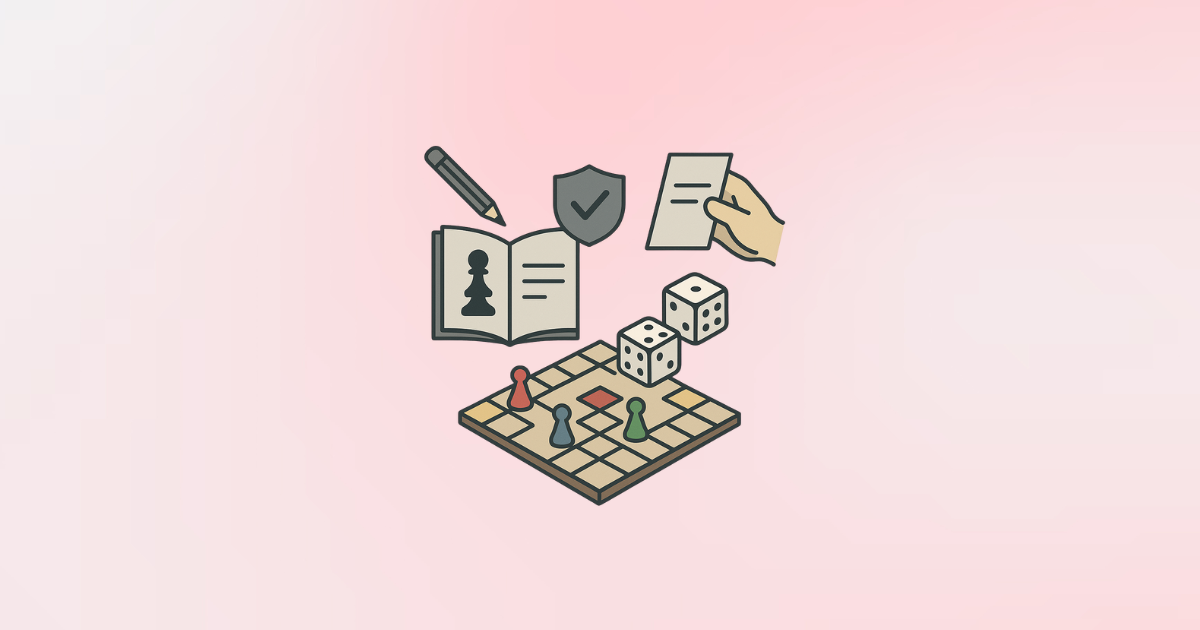Picture this: You've spent months perfecting your board game. The mechanics are solid, the artwork is stunning, and you're ready to share your creation with the world. But then you realize something - you need a rulebook that actually makes sense to players.
Here's the thing that might surprise you: manufacturers consistently report that instructions are among the most important elements of your game, yet they're often the most neglected. Many first-time designers focus all their energy on artwork and mechanics, leaving the board game instructions template as an afterthought.
Don't make this mistake. Your rulebook is the bridge between your brilliant game and confused players. Get it wrong, and even the best game can flop. Get it right, and you'll have players diving into your world from the first page.
In this guide, we'll walk through everything you need to know about choosing the perfect board game instructions template. Whether you're going digital or print, DIY or professional, we've got you covered.
Why Your Board Game Instructions Template Matters More Than You Think
Before we dive into formats and tools, let's talk about why this matters so much. A great board game instructions template does three crucial things:
- Gets players into the game faster - Clear, well-organized rules mean less confusion and more fun
- Reduces support headaches - Good instructions mean fewer "how do I play this?" emails
- Makes your game look professional - A polished rulebook signals quality to retailers and players
Think about the last time you opened a new board game. Did you groan when you saw a wall of text? Or did you feel excited because the rules looked easy to follow? That's the power of a good board game instructions template.
Understanding Physical Instruction Styles: The Big Three
When it comes to physical rulebooks, you've got three main formats to choose from. Each has its sweet spot, and picking the right one depends on your game's complexity and your budget.
Accordion Folds: The Space-Saver
Accordion-style instructions unfold like a roadmap, giving you a continuous flow of information. PrintNinja calls this one of their core formats, and for good reason.
Perfect for:
- Games with straightforward rules
- Quick reference guides
- Tight budgets
- Small box games
Watch out for:
- Limited space for complex explanations
- Can feel cramped with too much text
- Not great for games with lots of components
The beauty of accordion folds is their compactness. Players can unfold them completely to see all the rules at once, or fold them back to specific sections during play.
Small Booklets: The Professional Choice
Small booklets are like mini-magazines for your game. They're the Goldilocks option - not too simple, not too complex, but just right for most games.
Perfect for:
- Medium complexity games
- Games with multiple phases
- When you want that professional feel
- Games with 8-32 pages of rules
Consider these factors:
- Slightly higher printing costs
- Need good organization to avoid page-flipping
- Require more design work
Booklets give you room to breathe. You can include examples, diagrams, and step-by-step guides without cramming everything together.
Simple Folded Sheets: The Budget Hero
Sometimes simple is best. A single sheet folded into panels can work wonders for straightforward games.
Perfect for:
- Party games
- Simple strategy games
- Print-and-play versions
- Ultra-tight budgets
Limitations:
- Very limited space
- Not suitable for complex games
- Can look less professional
The key with folded sheets is making every word count. You need to be clear and concise because space is precious.
Beyond the Big Three
BoardGamesMaker expands the list with more specialized formats: bi-fold, z-fold, saddle-sewn, perfect-bound, and cross-fold booklets. Here's when to consider these:
- Perfect-bound booklets: For complex games with 48+ pages
- Saddle-sewn: Professional look for 16-64 page rulebooks
- Cross-fold: Unique presentation for special editions
Your choice comes down to three factors: page count, cost, and how portable you want your game to be.
Digital Tools That Make Creating Templates Easy
Now let's talk about the fun stuff - the tools that make creating your board game instructions template actually enjoyable instead of a nightmare.
Canva: The Beginner's Best Friend
Canva has revolutionized design for non-designers, and their board game templates are no exception. You can "play around with unique layouts for your game pieces and rules" without needing a design degree.
What makes Canva great:
- Ready-made board game instructions templates
- Drag-and-drop simplicity
- Tons of fonts and graphics
- Works great for both digital and print
Quick Canva tutorial:
- Search for "board game" templates
- Pick one that matches your game's style
- Replace the placeholder text with your rules
- Customize colors to match your game
- Download as PDF for printing
The best part? You can create multiple versions - a detailed rulebook and a quick reference card - using the same design elements.
Flippity: The Google Sheets Game-Changer
Here's something cool: Flippity lets you create board game instructions using Google Sheets. It sounds weird, but it's actually brilliant for certain types of games.
With Flippity, you can:
- Copy their spreadsheet template
- Edit each space's appearance
- Add instructions to specific spaces
- Customize card decks
- Upload images for tokens and dice
- Link to your own rulebook
This is perfect for creating digital versions of your game that people can play online while following your physical rulebook.
Rulebook.gg: The AI Game-Changer
Here's where things get really exciting. Rulebook.gg is an AI assistant specifically designed for writing and designing board game rulebooks. Think of it as having a professional game designer and technical writer working on your team.
What makes rulebook.gg special:
- Understands board game language and structure
- Helps organize complex rules into clear sections
- Suggests improvements for clarity
- Creates professional layouts automatically
- Ensures consistency across your entire rulebook
The AI can help you write rules that are 10× clearer than what most designers create on their own. It knows the common pitfalls and helps you avoid them from the start.
Software for Drafting Rules: Getting Your Words Right
Before you worry about making things look pretty, you need to get your words right. The board game design community on r/tabletopgamedesign swears by these tools for brainstorming and structuring rules.
Notion: The Flexible Organizer
Notion is like having a Swiss Army knife for rule writing. You can:
- Create databases of game components
- Link related rules together
- Collaborate with co-designers
- Keep track of changes through versions
Workflow tip: Create a master page with links to different sections (setup, gameplay, scoring, etc.). This makes it easy to jump between sections while writing.
Obsidian: The Connection Master
Obsidian excels at showing how different parts of your game connect. You can link related concepts and see how changes in one area affect others.
This is especially powerful for complex games where rules interact in multiple ways.
Microsoft Word: The Reliable Workhorse
Don't overlook the basics. Word is still great for:
- Track changes when collaborating
- Comments for feedback
- Familiar interface for most people
- Easy formatting options
Pro workflow: Draft in your preferred app (Notion, Obsidian, or Word), then transfer the content to your design tool for final formatting.
Making Your Board Game Instructions Template Clear and Professional
Here's where the rubber meets the road. You can have the fanciest template in the world, but if your content isn't clear, players will still be confused.
Test Early, Test Often
Before you finalize anything, get your board game instructions template in front of real people. Give them the rules and watch them try to play without your help.
What to watch for:
- Where do they hesitate?
- What questions do they ask?
- Do they miss important rules?
- Are they flipping back and forth between pages?
This testing phase is gold. One hour of watching confused players can save you months of customer support emails.
Consistency is King
Pick your terms and stick with them. If you call something a "resource card" on page 1, don't call it a "material token" on page 5.
Create a glossary of your game's terms and refer to it while writing. This simple step prevents a ton of confusion.
Visual Aids Are Your Friend
Don't just tell players what to do - show them. Include:
- Setup diagrams showing component placement
- Example turns with pictures
- Scoring examples with actual numbers
- Component callouts with clear labels
Remember: a picture really is worth a thousand words, especially in game rules.
File Preparation for Print
If you're going to print, you need to follow the printer's guidelines exactly. PrintNinja provides detailed file-preparation guides that cover:
- Correct dimensions and bleed areas
- Resolution requirements (usually 300 DPI)
- Color profiles (CMYK for print)
- Font embedding requirements
Getting this wrong means delays and extra costs, so don't skip this step.
Putting It All Together: Your Board Game Instructions Template Action Plan
Ready to create your own board game instructions template? Here's your step-by-step action plan:
Step 1: Choose Your Format (Week 1)
- Consider your game's complexity
- Think about your budget
- Decide between physical formats
Step 2: Draft Your Content (Week 2-3)
- Use Notion, Obsidian, or Word to write your rules
- Focus on clarity over cleverness
- Include examples for complex concepts
Step 3: Design Your Template (Week 4)
- Use Canva for simple designs
- Try Flippity for digital versions
- Consider rulebook.gg for AI assistance
Step 4: Test and Refine (Week 5-6)
- Test with different groups
- Watch for confusion points
- Revise based on feedback
Step 5: Prepare for Print (Week 7)
- Follow printer guidelines exactly
- Double-check all measurements
- Order a proof copy first
The Future of Board Game Instructions
The world of board game instructions is evolving fast. AI tools like rulebook.gg are making it easier than ever to create professional-quality rulebooks. Digital integration is becoming more common, with QR codes linking to video tutorials and interactive rule clarifications.
But here's the thing - no matter how fancy the technology gets, the fundamentals remain the same. Clear writing, logical organization, and thorough testing will always be the foundation of great board game instructions.
Your board game instructions template isn't just a necessary evil - it's an opportunity to make a great first impression and help players fall in love with your game. Take the time to get it right, use the tools that work for you, and don't be afraid to ask for help when you need it.
Remember, every great game designer started with their first rulebook. Yours might not be perfect, but with the right board game instructions template and a commitment to clarity, it can be the bridge that brings your amazing game to life for players around the world.
The most important thing? Start somewhere. Pick a format, choose your tools, and begin writing. Your game - and your players - will thank you for it.




